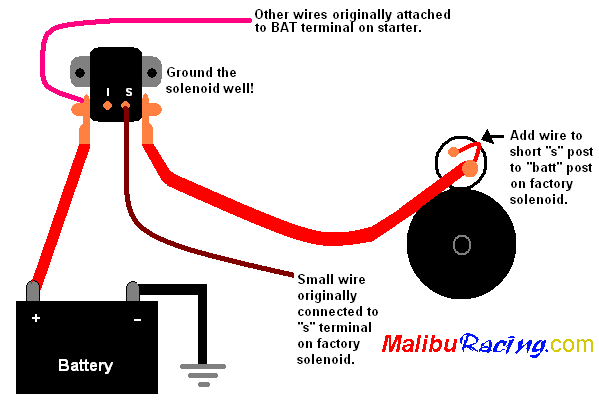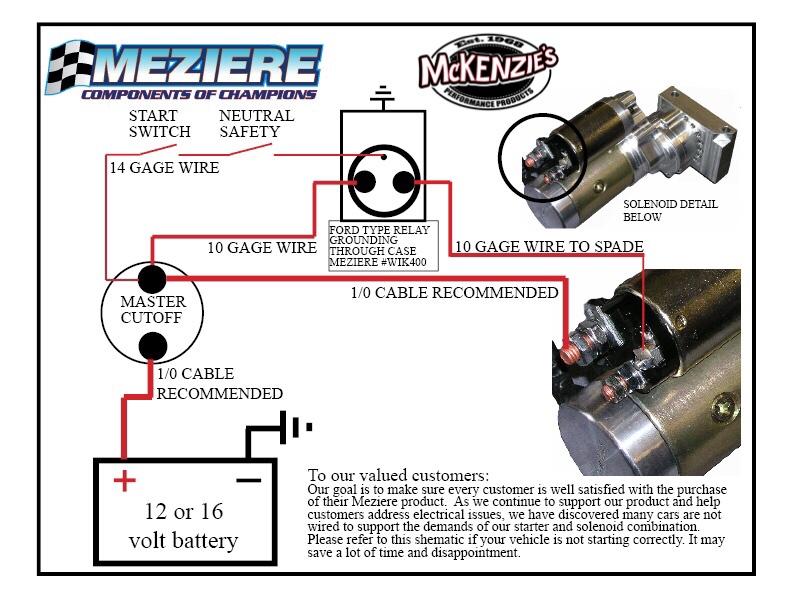Bracket Talk
Starter wire question
September 20, 2025, 07:01 PM
SpeierRacingHeadsStarter wire question
I'm rewiring my car. Using a K&R kit. I have used a Ford solenoid my entire life with the jumper wire. Being told the jumper wire is bad? I purchased a quality high amp GPE solenoid. How would you wire it?
Having the starter hot all the time isn't what I think I want?
Chad Speier
785-623-0963
September 20, 2025, 07:39 PM
Top355xI used a Biondo kit on my dragster I have a ford solenoid on the battery cable going to the starter so cable is only hot while cranking
September 20, 2025, 09:41 PM
Tom396quote:
Originally posted by SpeierRacingHeads:
I'm rewiring my car. Using a K&R kit. I have used a Ford solenoid my entire life with the jumper wire. Being told the jumper wire is bad? I purchased a quality high amp GPE solenoid. How would you wire it?
Having the starter hot all the time isn't what I think I want?
Me too. I think you know your answer. Take care. Tom Worthington
If it seems that bracket racing has gotten too expensive for you, maybe you are just doing it wrong.
September 21, 2025, 02:39 PM
183NI’ve run a ford style solenoid by the battery shutoff and a jumper wire to the solenoid on the starter forever on both cars. Wire is only hot when cranking. I’ve read it can cause timing issue with the bendix hot wiring it this way but I’ve never had a problem.
September 21, 2025, 08:51 PM
AlaskaracerThe latest trend is to use a high amp relay that connects to the battery cable post on the starter and the other to the solenoid to energize it. The theory behind this is maximum amperage/voltage to the solenoid while cranking, only using the starter switch to activate the relay. The battery cable goes from the master cutoff to the starter and is hot all the time when the disconnect switch is on. It works, been used on diesels for years. However, I run my battery cable from the battery to the master cutoff, then to a high amp relay (750 continuous, 2500 surge), then to the starter. At the starter I run a 10ga jumper to the solenoid from the battery terminal on the starter. The start button only activates my starter relay. Also been doing this for YEARS. The advantage to that is the main battery cable to the starter is only hot WHEN CRANKING, dead otherwise, which I feel is safer. Despite more main cable connections, I have measured less than a .1v drop from the battery to the starter when cranking on that cable, which is almost nothing. This is basically the same setup with a different relay than a ford relay. I've had the ford relays go bad quickly using 16v though, which is why I want to a different relay. Since then no failures.
Mark Goulette
Owner/Driver of the Livin' The Dream Racing dragster
www.livinthedreamracing.com"Speed kills but it's better than going slow!"
Authorized Amsoil Retailer
September 21, 2025, 08:59 PM
SpeierRacingHeadsquote:
Originally posted by Alaskaracer:
The latest trend is to use a high amp relay that connects to the battery cable post on the starter and the other to the solenoid to energize it. The theory behind this is maximum amperage/voltage to the solenoid while cranking, only using the starter switch to activate the relay. The battery cable goes from the master cutoff to the starter and is hot all the time when the disconnect switch is on. It works, been used on diesels for years. However, I run my battery cable from the battery to the master cutoff, then to a high amp relay (750 continuous, 2500 surge), then to the starter. At the starter I run a 10ga jumper to the solenoid from the battery terminal on the starter. The start button only activates my starter relay. Also been doing this for YEARS. The advantage to that is the main battery cable to the starter is only hot WHEN CRANKING, dead otherwise, which I feel is safer. Despite more main cable connections, I have measured less than a .1v drop from the battery to the starter when cranking on that cable, which is almost nothing. This is basically the same setup with a different relay than a ford relay. I've had the ford relays go bad quickly using 16v though, which is why I want to a different relay. Since then no failures.
Like this?

Chad Speier
785-623-0963
September 21, 2025, 09:01 PM
SpeierRacingHeadsor this?

Chad Speier
785-623-0963
September 22, 2025, 09:34 AM
markemark^^^ Both methods work (can possibly fail) and it’s a matter of preference to the user imho. I prefer using the solenoid on starter and having hot as this is the junction point for my 12v alternator sharing the same 2-gauge wire for the starter going back to battery. One could use a fusible link for protection when hot with master cutoff On.
September 22, 2025, 10:35 AM
ski_dwn_itK&R should have supplied you with a fuse for the master cutoff to the starter. At least my kit had one.
I have had nothing but problems with the Ford solenoids - forever banging on them and replacing on another car we have. And just another thing to go back at the worst possible time.
September 22, 2025, 12:08 PM
SpeierRacingHeadsquote:
Originally posted by ski_dwn_it:
K&R should have supplied you with a fuse for the master cutoff to the starter. At least my kit had one.
I have had nothing but problems with the Ford solenoids - forever banging on them and replacing on another car we have. And just another thing to go back at the worst possible time.
No fuse and this is what they want.

Chad Speier
785-623-0963
September 22, 2025, 12:19 PM
ski_dwn_itMy bad - mine was a pro street wiring setup from them. Mine has fuses on main and alternator. which I like incase those lines would short out in an accident or otherwise. The only live lines are the short runs from battery to shutoff.
I see no reason to run a separate solenoid - I would just run the wire from there board to the starter solenoid. As I said its one less thing to go wrong. That is the way mine is.
September 22, 2025, 12:26 PM
SpeierRacingHeadsquote:
Originally posted by ski_dwn_it:
My bad - mine was a pro street wiring setup from them. Mine has fuses on main and alternator. which I like incase those lines would short out in an accident or otherwise. The only live lines are the short runs from battery to shutoff.
I see no reason to run a separate solenoid - I would just run the wire from there board to the starter solenoid. As I said its one less thing to go wrong. That is the way mine is.
There are advantages to the solenoid. I just can't bring myself to have power at the starter all the time.
Chad Speier
785-623-0963
September 22, 2025, 12:51 PM
markemarkquote:
Originally posted by SpeierRacingHeads: There are advantages to the solenoid. I just can't bring myself to have power at the starter all the time.
That wiring diagram is a “suggestion” to how one could wire. If racing a x/hra class, if it complies with the rule book, it is legal.
If one saw/ understood what I did to the DD relay board wiring in my car to make it work for me they’d agree.
September 22, 2025, 01:14 PM
LincolnCall Kevin and ask. I think he is suggesting using the ford solenoid as a heavy duty relay these days. He explained it to me and I changed my car but I don't remember well enough to explain it here.
September 22, 2025, 03:24 PM
AlaskaracerChad, yes to the first drawing
Mark Goulette
Owner/Driver of the Livin' The Dream Racing dragster
www.livinthedreamracing.com"Speed kills but it's better than going slow!"
Authorized Amsoil Retailer
September 22, 2025, 04:32 PM
SP 124Xquote:
Originally posted by markemark:
^^^ Both methods work (can possibly fail) and it’s a matter of preference to the user imho. I prefer using the solenoid on starter and having hot as this is the junction point for my 12v alternator sharing the same 2-gauge wire for the starter going back to battery. One could use a fusible link for protection when hot with master cutoff On.
This is my preferred method as well using a 4 post cutoff switch or two constant duty solenoids.
Denis LeBlanc
September 22, 2025, 05:27 PM
SpeierRacingHeadsThis is how I'm going to do it. Then run a separate wire to the master for the ignition, shift box, computer.

Chad Speier
785-623-0963
September 22, 2025, 08:46 PM
moparacerquote:
Originally posted by SpeierRacingHeads:
quote:
Originally posted by ski_dwn_it:
My bad - mine was a pro street wiring setup from them. Mine has fuses on main and alternator. which I like incase those lines would short out in an accident or otherwise. The only live lines are the short runs from battery to shutoff.
I see no reason to run a separate solenoid - I would just run the wire from there board to the starter solenoid. As I said its one less thing to go wrong. That is the way mine is.
There are advantages to the solenoid. I just can't bring myself to have power at the starter all the time.
And disadvantages. I had trouble with relays a couple times. I used to run a relay and got away from it. Hot wire to starter and use the relay on the starter now. Why reinvent the wheel. My 14:1 engine starts as good as you could ever want for a 12 Volt alky injected deal.
September 22, 2025, 09:38 PM
markemarkquote:
Originally posted by SpeierRacingHeads:This is how I'm going to do it. Then run a separate wire to the master for the ignition, shift box, computer.
If not using an alternator, consider just attaching a 6 gauge wire to the hot side of the stater relay to feed the relay board with. It’s location is perfect for this.
September 23, 2025, 07:45 AM
BD104XFollowing... I never believed in adding any extra relays or solenoids either but after switching to a high-HP starter, the neutral safety switch in my shifter (older Outlaw) won't handle the load.
Billy Duhs - BD104X@gmail.com



